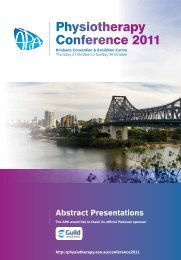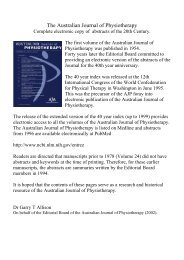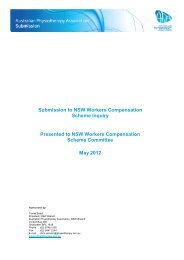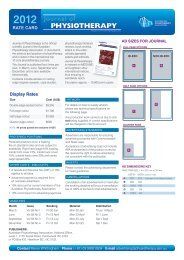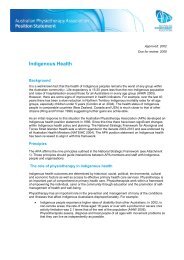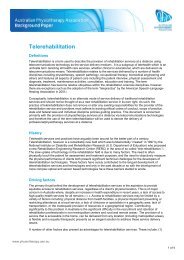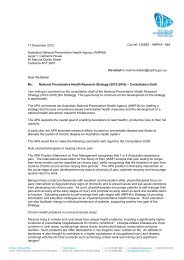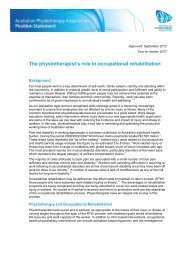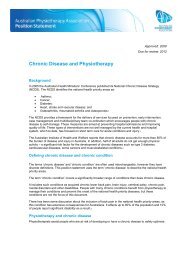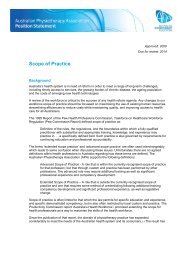2009 APA Conference Week Abstracts - Australian Physiotherapy ...
2009 APA Conference Week Abstracts - Australian Physiotherapy ...
2009 APA Conference Week Abstracts - Australian Physiotherapy ...
You also want an ePaper? Increase the reach of your titles
YUMPU automatically turns print PDFs into web optimized ePapers that Google loves.
National Paediatric Group<br />
and development of allied health paediatric staff equivalent<br />
full time positions and built expertise in the management<br />
of infants at risk of developmental delay. For example:<br />
the 3-day per week, part time service provided by 2.2<br />
equivalent full time allied health staff in 2004 has grown to<br />
become a full-time service offered across two campuses and<br />
comprising 10.8 equivalent full time allied health staff, plus<br />
sessional developmental paediatricians and 0.6 equivalent<br />
full time paediatric fellows. A pilot project to investigate<br />
the need for an allied health developmental service in the<br />
special care nursery informed a successful business case<br />
that has resulted in 2.3 equivalent full time allied health<br />
staff employed into this service. This is an overall allied<br />
health paediatrics workforce increase from 2.2 equivalent<br />
full time in 2004 to 13.1 equivalent full time in 2008. This<br />
paper will outline the successes and challenges of this<br />
service growth and discuss strategies for sustainability and<br />
further development<br />
6<br />
Treatment of the recurrent clubfoot with the Ponseti<br />
technique<br />
Evans KG, Gibbons P, Latimer M<br />
The Children’s Hospital at Westmead, Sydney<br />
The successful use of the Ponseti Technique in the<br />
treatment of recurrent clubfoot has been documented but not<br />
quantified in the literature. Prior to the introduction of this<br />
technique, those children with recurrent congenital talipes<br />
equinovarus deformity were treated with surgery. It is now<br />
well established that extensive surgery leads to poor long<br />
term outcomes. At The Children’s Hospital at Westmead<br />
it has become common practice to treat the recurrent<br />
clubfoot with the same Ponseti serial casting technique<br />
used in neonates. A retrospective chart audit of 55 patients<br />
with 96 clubfeet who underwent Ponseti serial casting for<br />
congenital talipes equinovarus between 2001–2008 was<br />
performed. Our aim was to quantify the outcome of these<br />
patients following serial casting. Outcome was measured<br />
according to surgical intervention required after casting.<br />
Major surgery was considered a failure; minor or no surgery<br />
was considered a success. Major surgery was defined as<br />
intra-articular procedures including posteromedial soft<br />
tissue release. Minor surgery was defined as extra-articular<br />
procedures including tibialis anterior tendon transfer. Our<br />
results post casting showed a marked decrease in surgery<br />
with 4 feet requiring major surgery (4%); 25 feet (26%)<br />
undergoing minor surgery and 67 feet (70%) requiring no<br />
surgery. Thus there was an overall success rate of 96%. The<br />
use of the Ponseti technique for the treatment of recurrent<br />
talipes equinovarus is recommended to reduce the need for<br />
both major and minor surgery in this population and thus<br />
produce good long term outcomes.<br />
Improving reliability of the clinical assessment of<br />
spasticity: the <strong>Australian</strong> Spasticity Assessment Scale<br />
Gibson N, 1,2,4 Love SC, 1,2,3,4 Blair E 1,2,4<br />
1<br />
Princess Margaret Hospital, Perth, 2 University of Western Australia,<br />
Perth, 3 Curtin University of Technology, Perth, 4 The Telethon Institute<br />
for Child Health, Perth<br />
We sought to improve our current methods of identifying<br />
and assessing spasticity by developing a more valid,<br />
reliable and clinically applicable tool, the <strong>Australian</strong><br />
Spasticity Assessment Scale. The most frequently used<br />
tool, the Modified Ashworth Scale does not conform to the<br />
definition of spasticity and has poor to mediocre reliability.<br />
The <strong>Australian</strong> Spasticity Assessment Scale was developed,<br />
using the framework of the Modified Ashworth Scale but<br />
conforming to the definition of spasticity. An explicit yet<br />
simple standardised test protocol is provided together<br />
with unambiguous, mutually exclusive scoring criteria,<br />
so that every muscle tested fits into one and only one<br />
category. Inter-rater reliability of the <strong>Australian</strong> Spasticity<br />
Assessment Scale was assessed in an outpatient setting of a<br />
tertiary paediatric hospital. Three raters used the <strong>Australian</strong><br />
Spasticity Assessment Scale to independently assess the<br />
spasticity of muscles in 23 children with a wide range of<br />
subtypes and functional levels of spastic cerebral palsy (n =<br />
322 muscle groups). Agreement was measured with kappa,<br />
and, in order to compare with estimates of reliability of preexisting<br />
methods, with intra-class correlation. Substantial<br />
agreement was demonstrated by kappa = 0.71 (95% CI 0.67–<br />
0.75). Intraclass correlation was 0.88 (95% CI 0.86–0.90),<br />
significantly better than that published for other methods<br />
of assessment. The <strong>Australian</strong> Spasticity Assessment Scale<br />
conforms to the definition of spasticity, is easily clinically<br />
applicable and reliability exceeds that of other commonly<br />
used spasticity scoring systems and we suggest it should<br />
be the tool of choice for assessing spasticity in the clinical<br />
setting.<br />
Towards a sustainable clinical education model for<br />
paediatric physiotherapy: the experience of building<br />
capacity for physiotherapy students at the Children’s<br />
Health Service District in Queensland<br />
Henderson DR, 1 Wright S, 1 Maharaj S, 2 Moller M 1<br />
1<br />
Dept of PT, Royal Children’s Hospital, Brisbane, 2 Queensland<br />
Paediatric Rehabilitation Service, Brisbane<br />
It is well recognised nationally that clinical education for<br />
entry level physiotherapy students faces building pressure<br />
from increasing clinical demands, growing student numbers<br />
and reducing educational funding. The way forward is<br />
unclear with systematic review of physiotherapy clinical<br />
education literature concluding that ‘no model is more<br />
effective than another’. How does a busy physiotherapy<br />
department build sustainable capacity to support the next<br />
generation of therapists? What model of clinical education<br />
best supports the local needs, what steps are involved in its<br />
formation and are they transferable to other physiotherapy<br />
departments? The purpose of this study is to analyse the<br />
efficacy of an innovative pilot model of clinical education and<br />
describe the lessons learnt to facilitate broader adaptation.<br />
This model aims to incorporate strategies to unload busy<br />
clinicians while supporting students’ learning curve of skills<br />
attainment. A mixed action research design used features<br />
of qualitative semi-structured interviews, focus groups and<br />
observational analysis combined with quantitative time/<br />
motion study tools and survey data. Innovative models<br />
for assessing student attainment of competencies e.g the<br />
MiniCEX, an assessment tool of clinical skills validated in<br />
medicine, are investigated. Participants include members<br />
of the paediatric physiotherapy services in the Children’s<br />
Health Service District of Queensland based at Royal<br />
Children’s Hospital (RCH) in Brisbane, and other key<br />
stakeholders such as students, parents and patients. The<br />
results of the pilot are still being gathered in collaboration<br />
with university educators in Queensland and the project is<br />
due to report in August <strong>2009</strong>.<br />
The e-AJP Vol 55: 4, Supplement



